Jackson M.J. Micro and Nanomanufacturing
Подождите немного. Документ загружается.

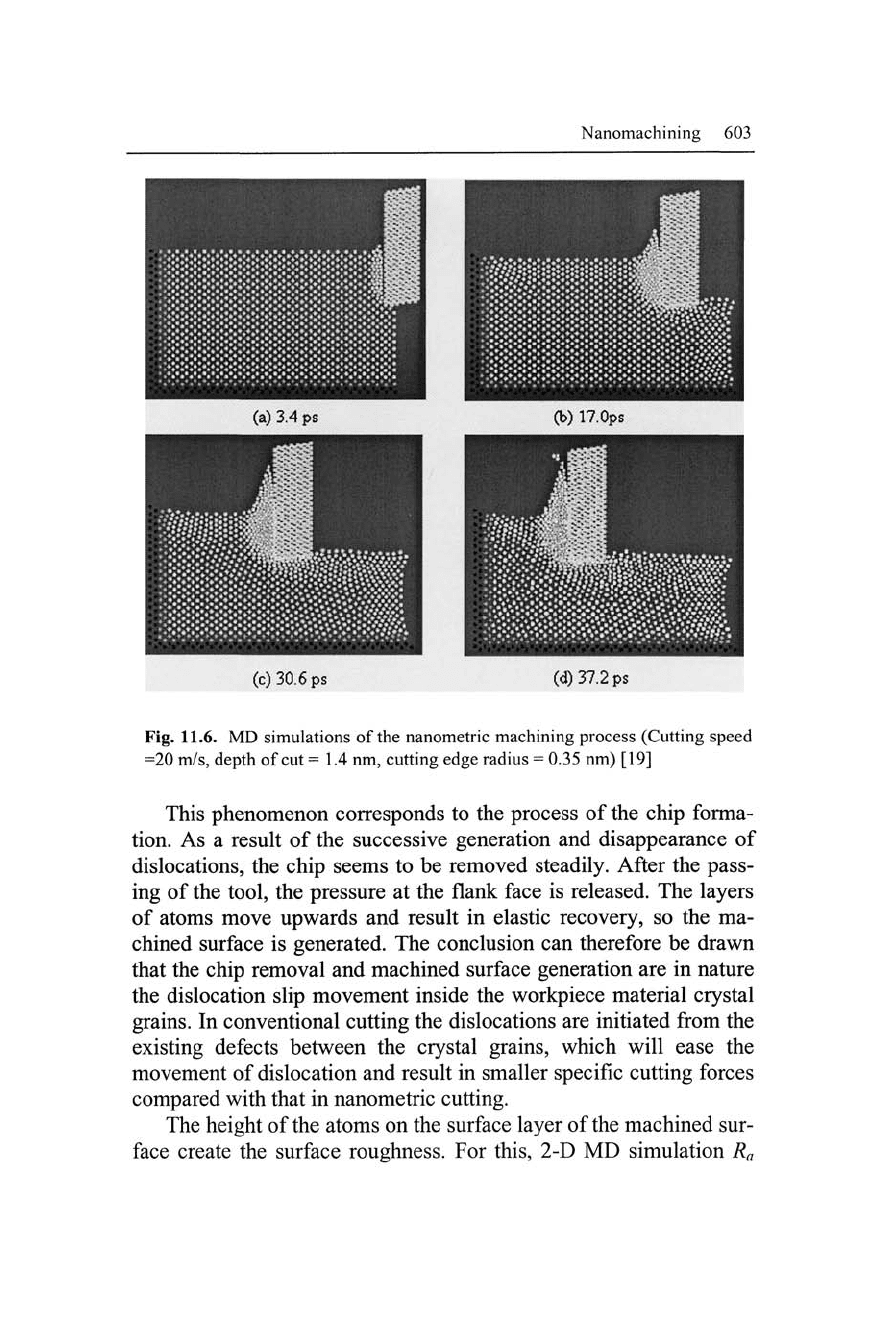
Nanomachining 603
(c) 30.6 ps
(d)37.2ps
Fig. 11.6. MD simulations of the nanometric machining process (Cutting speed
=20 m/s, depth of cut = 1.4 nm, cutting edge radius = 0.35 nm) [19]
This phenomenon corresponds to the process of the chip forma-
tion. As a result of the successive generation and disappearance of
dislocations, the chip seems to be removed steadily. After the pass-
ing of the tool, the pressure at the flank face is released. The layers
of atoms move upwards and result in elastic recovery, so the ma-
chined surface is generated. The conclusion can therefore be drawn
that the chip removal and machined surface generation are in nature
the dislocation slip movement inside the workpiece material crystal
grains. In conventional cutting the dislocations are initiated from the
existing defects between the crystal grains, which will ease the
movement of dislocation and result in smaller specific cutting forces
compared with that in nanometric cutting.
The height of the atoms on the surface layer of
the
machined sur-
face create the surface roughness. For this, 2-D MD simulation Ra
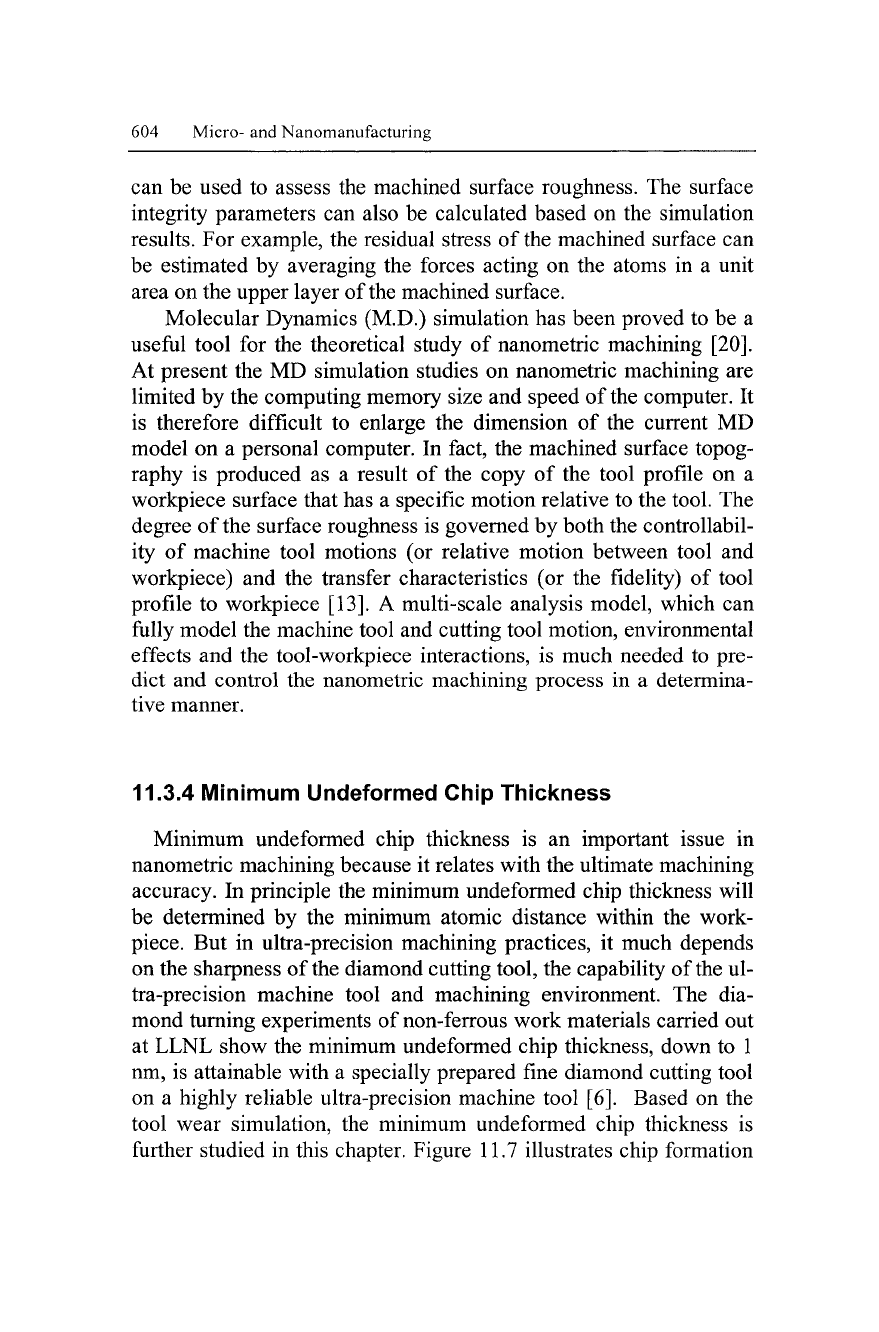
604 Micro- and Nanomanufacturing
can be used to assess the machined surface roughness. The surface
integrity parameters can also be calculated based on the simulation
results. For example, the residual stress of the machined surface can
be estimated by averaging the forces acting on the atoms in a unit
area on the upper layer of the machined surface.
Molecular Dynamics (M.D.) simulation has been proved to be a
useful tool for the theoretical study of nanometric machining [20].
At present the MD simulation studies on nanometric machining are
limited by the computing memory size and speed of the computer. It
is therefore difficult to enlarge the dimension of the current MD
model on a personal computer. In fact, the machined surface topog-
raphy is produced as a result of the copy of the tool profile on a
workpiece surface that has a specific motion relative to the tool. The
degree of the surface roughness is governed by both the controllabil-
ity of machine tool motions (or relative motion between tool and
workpiece) and the transfer characteristics (or the fidelity) of tool
profile to workpiece [13]. A multi-scale analysis model, which can
fully model the machine tool and cutting tool motion, environmental
effects and the tool-workpiece interactions, is much needed to pre-
dict and control the nanometric machining process in a determina-
tive manner.
11.3.4 Minimum Undeformed Chip Thickness
Minimum undeformed chip thickness is an important issue in
nanometric machining because it relates with the ultimate machining
accuracy. In principle the minimum undeformed chip thickness will
be determined by the minimum atomic distance within the work-
piece. But in ultra-precision machining practices, it much depends
on the sharpness of the diamond cutting tool, the capability of the ul-
tra-precision machine tool and machining environment. The dia-
mond turning experiments of non-ferrous work materials carried out
at LLNL show the minimum undeformed chip thickness, down to 1
nm, is attainable with a specially prepared fine diamond cutting tool
on a highly reliable ultra-precision machine tool [6]. Based on the
tool wear simulation, the minimum undeformed chip thickness is
further studied in this chapter. Figure 11.7 illustrates chip formation
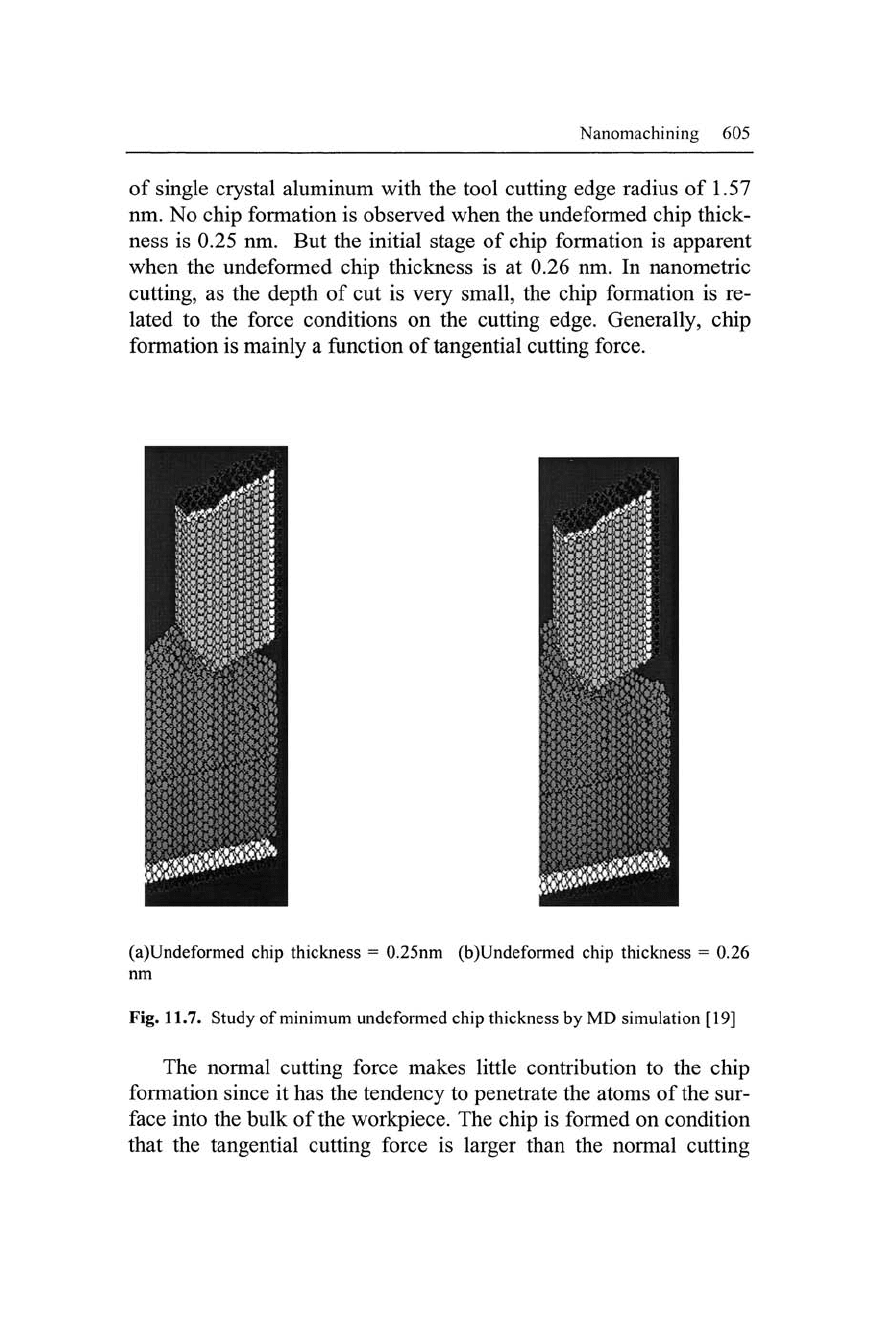
Nanomachining 605
of single crystal aluminum with the tool cutting edge radius of 1.57
nm. No chip formation is observed when the undeformed chip thick-
ness is 0.25 nm. But the initial stage of chip formation is apparent
when the undeformed chip thickness is at 0.26 nm. In nanometric
cutting, as the depth of cut is very small, the chip formation is re-
lated to the force conditions on the cutting edge. Generally, chip
formation is mainly a function of tangential cutting force.
(a)Undeformed chip thickness = 0.25nm (b)Undeformed chip thickness = 0.26
nm
Fig. 11.7. Study of minimum undeformed chip thickness by MD simulation [19]
The normal cutting force makes little contribution to the chip
formation since it has the tendency to penetrate the atoms of the sur-
face into the bulk of the workpiece. The chip is formed on condition
that the tangential cutting force is larger than the normal cutting
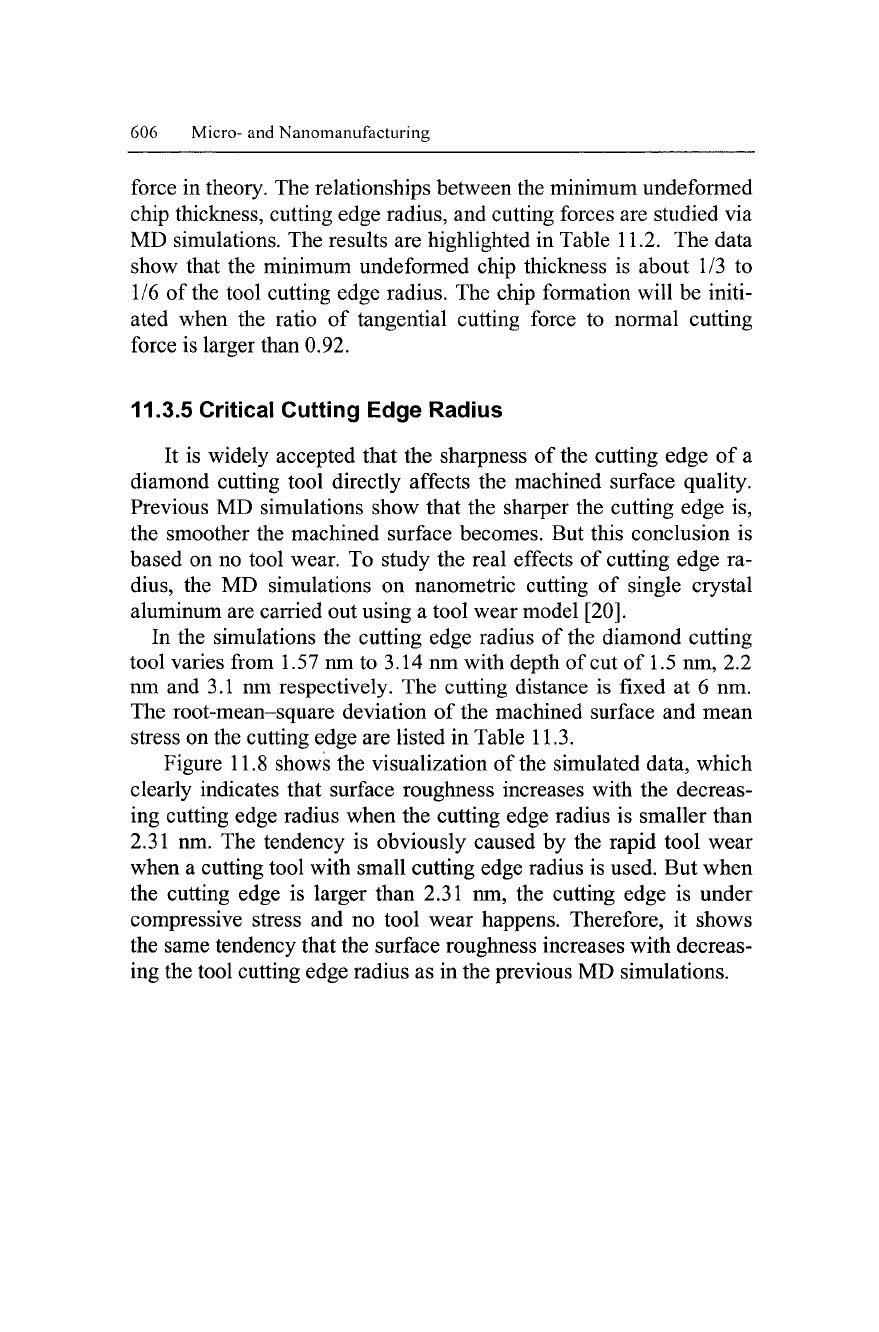
606 Micro- and Nanomanufacturing
force in theory. The relationships between the minimum undeformed
chip thickness, cutting edge radius, and cutting forces are studied via
MD simulations. The results are highlighted in Table 11.2. The data
show that the minimum undeformed chip thickness is about 1/3 to
1/6 of the tool cutting edge radius. The chip formation will be initi-
ated when the ratio of tangential cutting force to normal cutting
force is larger than 0.92.
11.3.5 Critical Cutting Edge Radius
It is widely accepted that the sharpness of the cutting edge of a
diamond cutting tool directly affects the machined surface quality.
Previous MD simulations show that the sharper the cutting edge is,
the smoother the machined surface becomes. But this conclusion is
based on no tool wear. To study the real effects of cutting edge ra-
dius,
the MD simulations on nanometric cutting of single crystal
aluminum are carried out using a tool wear model [20].
In the simulations the cutting edge radius of the diamond cutting
tool varies from 1.57 nm to 3.14 nm with depth of cut of 1.5 nm, 2.2
nm and 3.1 nm respectively. The cutting distance is fixed at 6 nm.
The root-mean-square deviation of the machined surface and mean
stress on the cutting edge are listed in Table 11.3.
Figure 11.8 shows the visualization of the simulated data, which
clearly indicates that surface roughness increases with the decreas-
ing cutting edge radius when the cutting edge radius is smaller than
2.31 nm. The tendency is obviously caused by the rapid tool wear
when a cutting tool with small cutting edge radius is used. But when
the cutting edge is larger than 2.31 nm, the cutting edge is under
compressive stress and no tool wear happens. Therefore, it shows
the same tendency that the surface roughness increases with decreas-
ing the tool cutting edge radius as in the previous MD simulations.
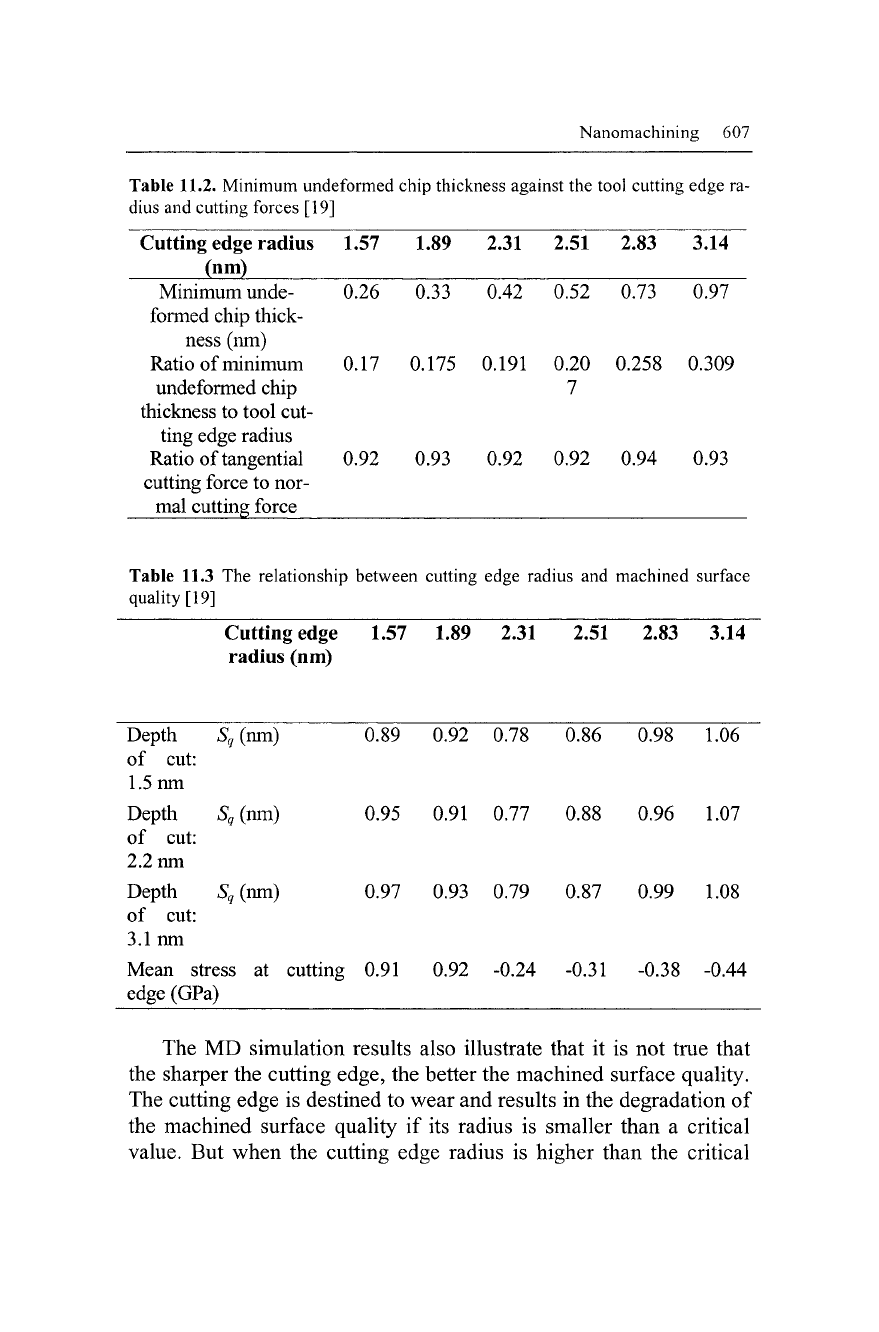
Nanomachining 607
Table 11.2. Minimum undeformed chip thickness against the tool cutting edge ra-
dius and cutting forces [19]
Cutting edge radius 1.57 1.89 2ji 2^51 L83 3.14
(nm)
Minimum unde- 0.26 0.33 0.42 0.52 0.73 0.97
formed chip thick-
ness (nm)
Ratio of minimum 0.17 0.175 0.191 0.20 0.258 0.309
undeformed chip 7
thickness to tool cut-
ting edge radius
Ratio of tangential 0.92 0.93 0.92 0.92 0.94 0.93
cutting force to nor-
mal cutting force
Table 11.3 The relationship between cutting edge radius and machined surface
quality [19]
Cutting edge EST h89 2J1 Isi 2^83 3.14
radius (nm)
Depth Sg(mn) 0.89 0.92 0.78 0.86 0.98 1.06
of cut:
1.5 nm
Depth 5,(nm) 0.95 0.91 0.77 0.88 0.96 1.07
of cut:
2.2 nm
Depth 5,(nm) 0.97 0.93 0.79 0.87 0.99 1.08
of cut:
3.1 nm
Mean stress at cutting 0.91 0.92 -0.24 -0.31 -0.38 -0.44
edge (GPa)
The IVID simulation results also illustrate that it is not true that
the sharper the cutting edge, the better the machined surface quality.
The cutting edge is destined to wear and results in the degradation of
the machined surface quality if its radius is smaller than a critical
value. But when the cutting edge radius is higher than the critical
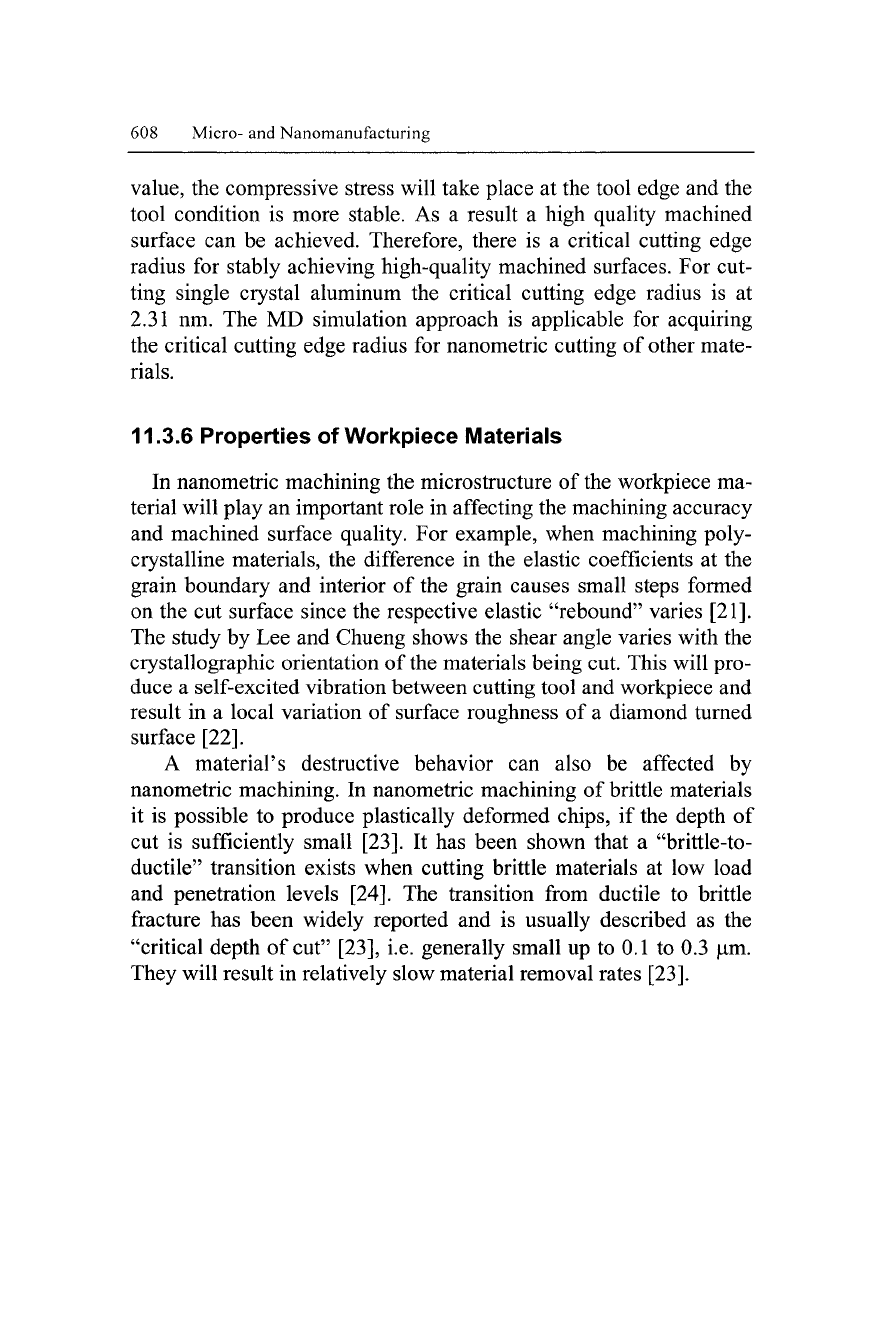
608 Micro- and Nanomanufacturing
value, the compressive stress will take place at the tool edge and the
tool condition is more stable. As a result a high quality machined
surface can be achieved. Therefore, there is a critical cutting edge
radius for stably achieving high-quality machined surfaces. For cut-
ting single crystal aluminum the critical cutting edge radius is at
2.31 nm. The MD simulation approach is applicable for acquiring
the critical cutting edge radius for nanometric cutting of other mate-
rials.
11.3.6 Properties of Workpiece Materials
In nanometric machining the microstructure of the workpiece ma-
terial will play an important role in affecting the machining accuracy
and machined surface quality. For example, when machining poly-
crystalline materials, the difference in the elastic coefficients at the
grain boundary and interior of the grain causes small steps formed
on the cut surface since the respective elastic "rebound" varies [21].
The study by Lee and Chueng shows the shear angle varies with the
crystallographic orientation of the materials being cut. This will pro-
duce a self-excited vibration between cutting tool and workpiece and
result in a local variation of surface roughness of a diamond turned
surface [22].
A material's destructive behavior can also be affected by
nanometric machining. In nanometric machining of brittle materials
it is possible to produce plastically deformed chips, if the depth of
cut is sufficiently small [23]. It has been shown that a "brittle-to-
ductile" transition exists when cutting brittle materials at low load
and penetration levels [24]. The transition from ductile to brittle
fracture has been widely reported and is usually described as the
"critical depth of cut" [23], i.e. generally small up to 0.1 to 0.3 |Lim.
They will result in relatively slow material removal rates [23].
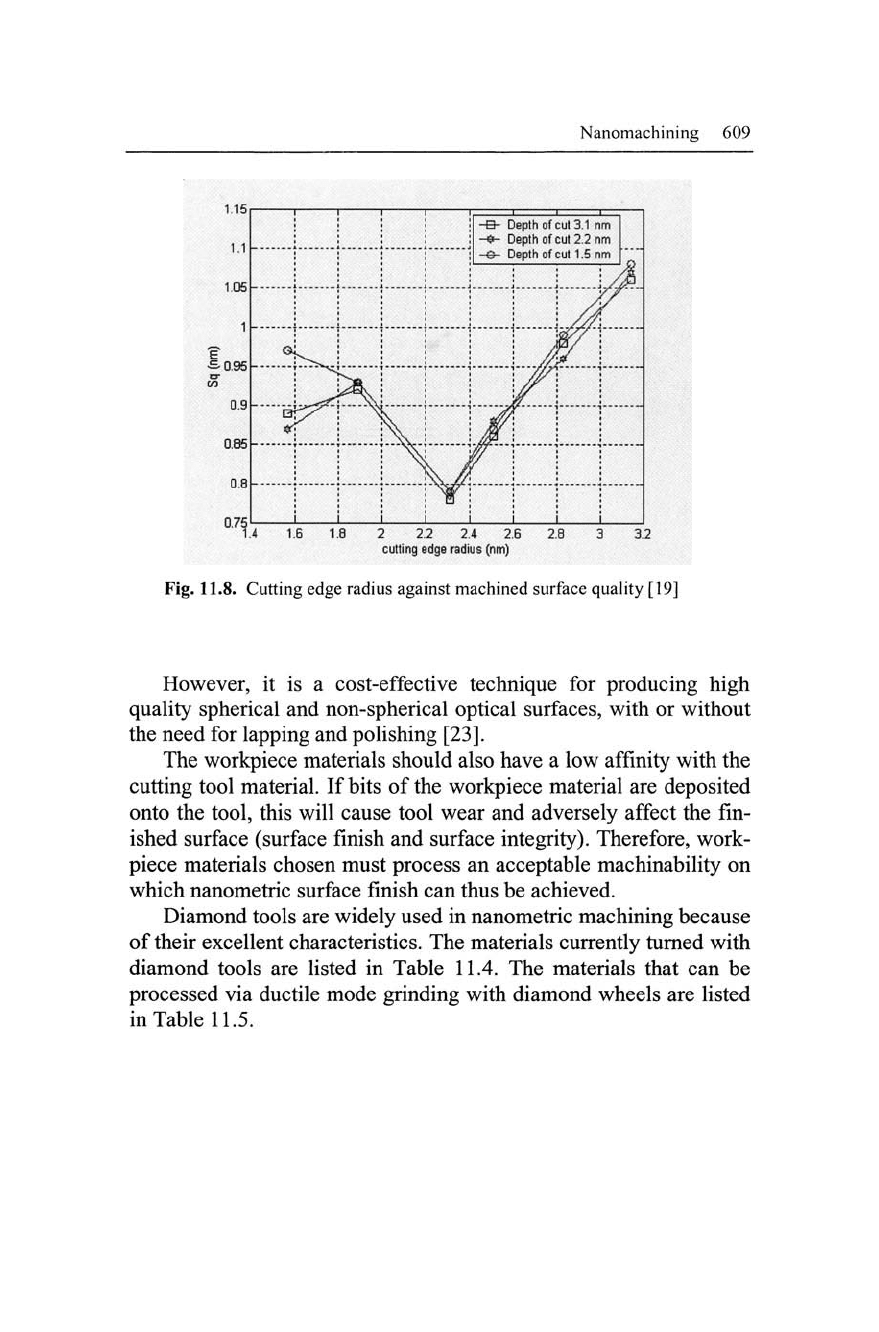
Nanomachining 609
1.15
1,1
1.05
e
-£•0.95
0.9
0.85
0.6
0.75
1 1
—-A>-?^
1 1
1
;
i
-- j
|\
: ^
i
r
-B-
Depth of cut
3.1
nm
-^ Depth of cut 2.2 nm
-e-
Depth of cut 1.5 nm
;
; 1
I \^
\
M( \
;
i
...J
i 1
1.6 1.8 2 2.2 2.4 2.6 2.8
cutting edge radius (nm)
3.2
Fig. 11.8. Cutting edge radius against machined surface quality [19]
However, it is a cost-effective technique for producing high
quaUty spherical and non-spherical optical surfaces, with or without
the need for lapping and polishing [23].
The workpiece materials should also have a low affinity with the
cutting tool material. If bits of the workpiece material are deposited
onto the tool, this will cause tool wear and adversely affect the fin-
ished surface (surface finish and surface integrity). Therefore, work-
piece materials chosen must process an acceptable machinability on
which nanometric surface finish can thus be achieved.
Diamond tools are widely used in nanometric machining because
of their excellent characteristics. The materials currently turned with
diamond tools are Ksted in Table 11.4. The materials that can be
processed via ductile mode grinding with diamond wheels are listed
in Table 11.5.
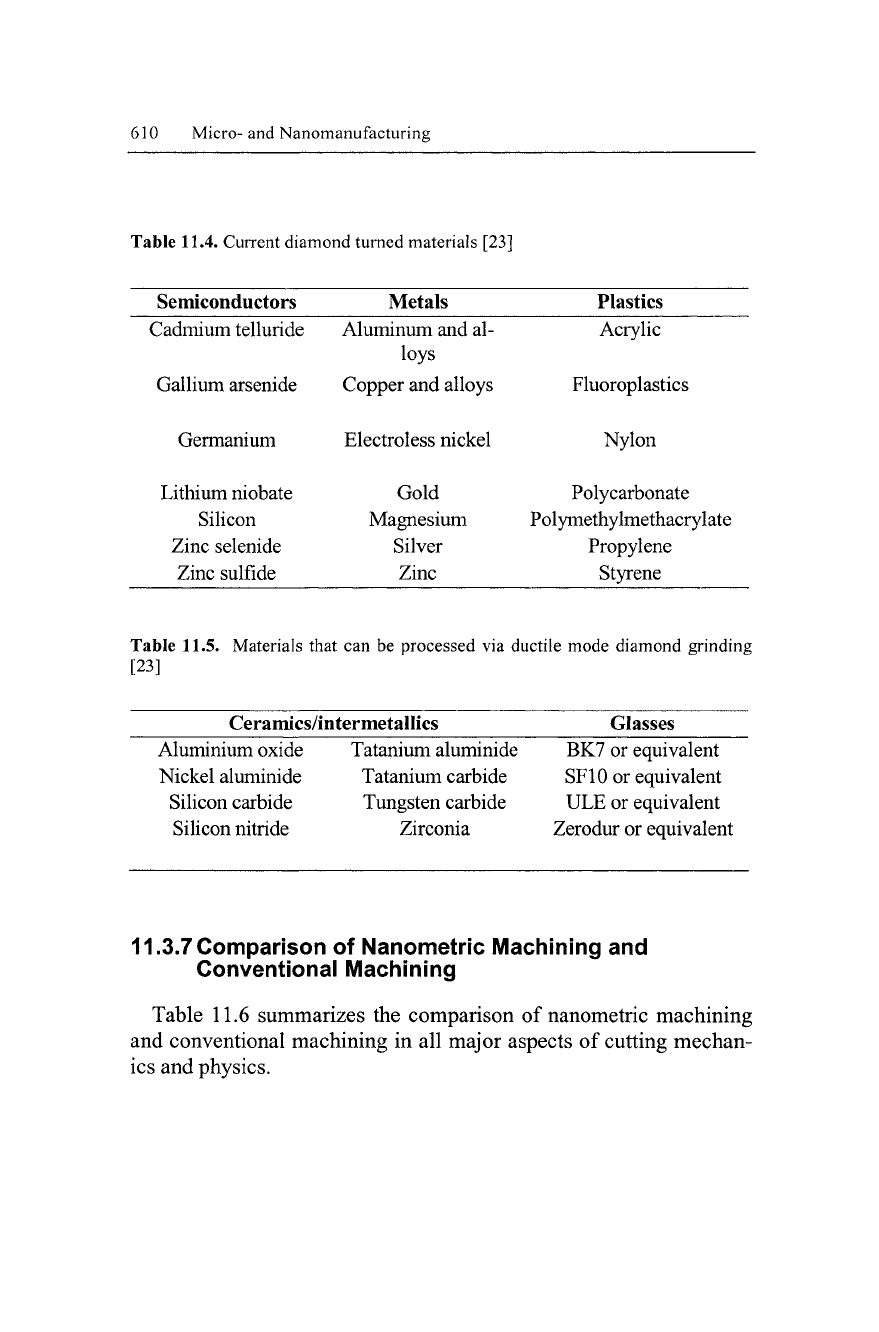
610 Micro- and Nanomanufacturing
Table 11.4. Current diamond turned materials [23]
Semiconductors
Cadmium telluride
Gallium arsenide
Germanium
Lithium niobate
Silicon
Zinc selenide
Zinc sulfide
Metals
Aluminum and al-
loys
Copper and alloys
Electroless nickel
Gold
Magnesium
Silver
Zinc
Plastics
Acrylic
Fluoroplastics
Nylon
Polycarbonate
Polymethylmethacrylate
Propylene
Styrene
Table 11.5. Materials that can be processed via ductile mode diamond grinding
[23]
Ceramics/intermetallics Glasses
Aluminium oxide
Nickel aluminide
Sihcon carbide
Silicon nitride
Tatanium aluminide
Tatanium carbide
Tungsten carbide
Zirconia
BK7 or equivalent
SFIO or equivalent
ULE or equivalent
Zerodur or equivalent
11.3.7 Comparison of Nanometric Machining and
Conventional Machining
Table 11.6 summarizes the comparison of nanometric machining
and conventional machining in all major aspects of cutting mechan-
ics and physics.
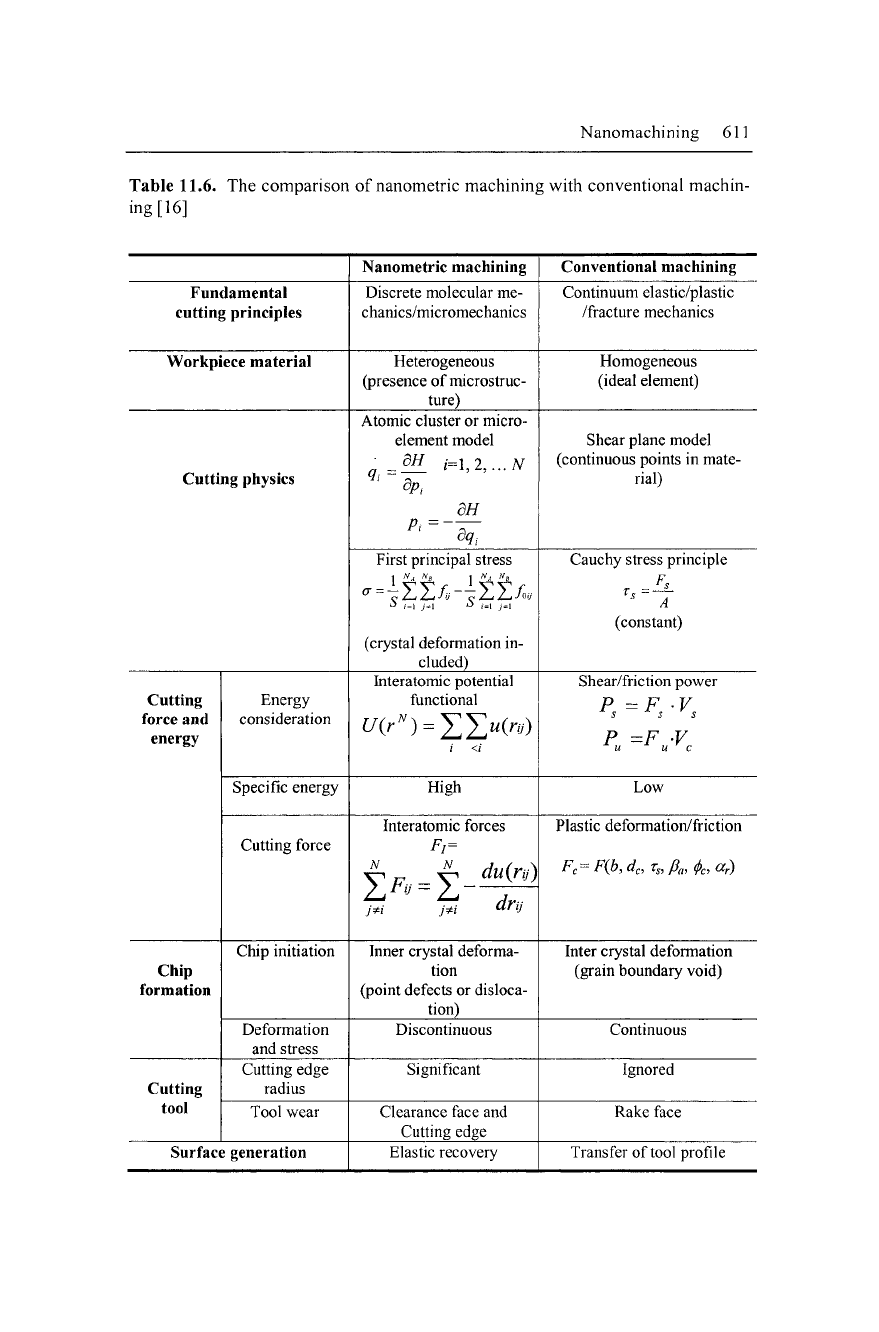
Nanomachining 611
Table 11.6. The comparison of nanometric machining with conventional machin-
ing[16]
Fundamental
cutting principles
Workpiece material
Cutting physics
Cutting
force and
energy
Chip
formation
Cutting
tool
Energy
consideration
Specific energy
Cutting force
Chip initiation
Deformation
and stress
Cutting edge
radius
Tool wear
Surface generation
Nanometric machining
Discrete molecular me-
chanics/micromechanics
Heterogeneous
(presence of microstruc-
ture)
Atomic cluster or micro-
element model
dH
First principal stress
\ ^ A ^B 1 ^A ^B
(crystal deformation in-
cluded)
Interatomic potential
functional
High
Interatomic forces
2^
'~2^ A
Inner crystal deforma-
tion
(point defects or disloca-
tion)
Discontinuous
Significant
Clearance face and
Cutting edge
Elastic recovery
Conventional machining
Continuum elastic/plastic
/fracture mechanics
Homogeneous
(ideal element)
Shear plane model
(continuous points in mate-
rial)
Cauchy stress principle
r =^
' A
(constant)
Shear/friction power
P =F -V
s s s
P =F V
u u c
Low
Plastic deformation/friction
Fc=F(b,dc, Ts, fia, (pc, (Xr)
Inter crystal deformation
(grain boundary void)
Continuous
Ignored
Rake face
Transfer of tool profile
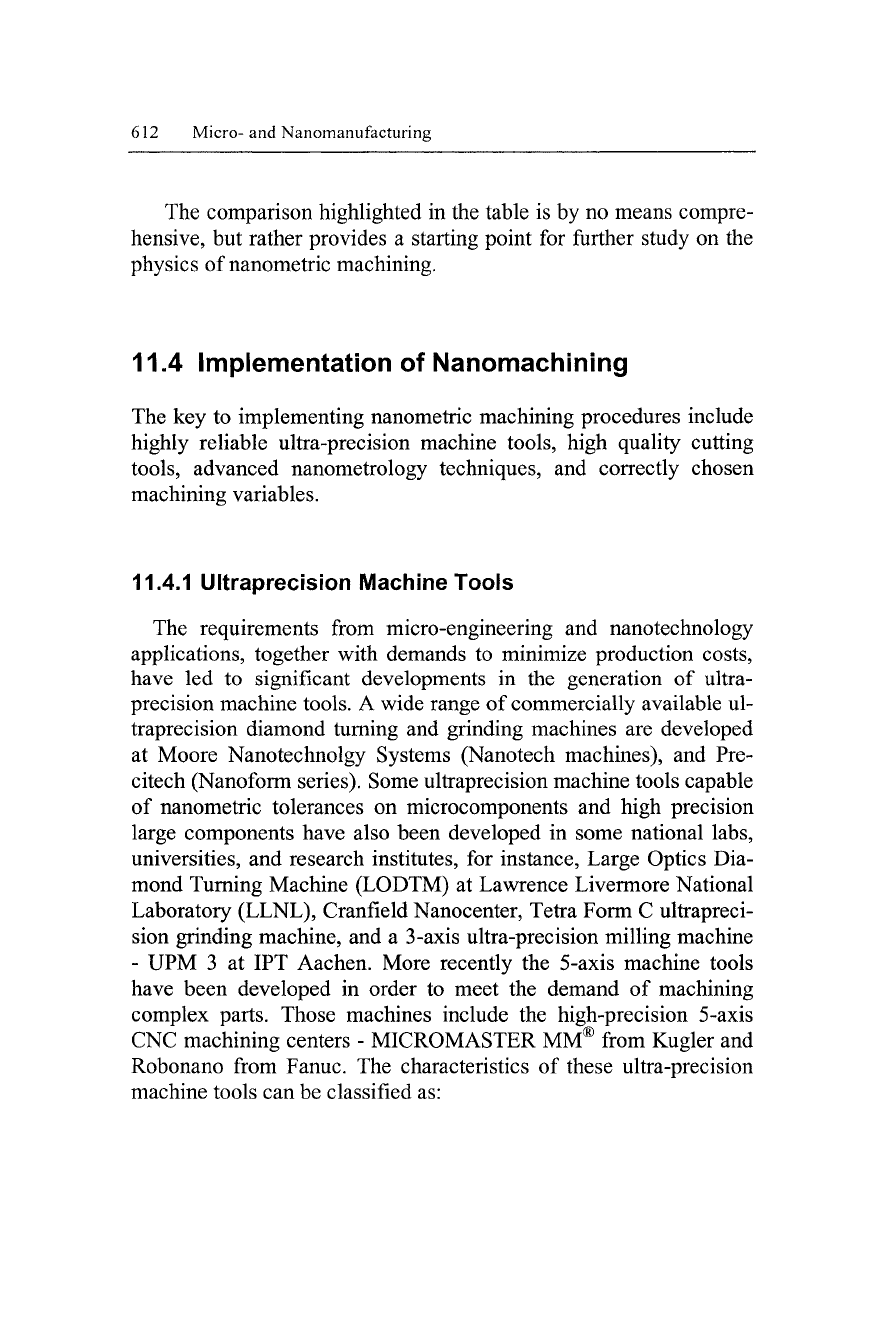
612 Micro- and Nanomanufacturing
The comparison highlighted in the table is by no means compre-
hensive, but rather provides a starting point for further study on the
physics of nanometric machining.
11.4 Implementation of Nanomachining
The key to implementing nanometric machining procedures include
highly reliable ultra-precision machine tools, high quality cutting
tools,
advanced nanometrology techniques, and correctly chosen
machining variables.
11.4.1 Ultraprecision Machine Tools
The requirements from micro-engineering and nanotechnology
applications, together with demands to minimize production costs,
have led to significant developments in the generation of ultra-
precision machine tools. A wide range of commercially available ul-
traprecision diamond turning and grinding machines are developed
at Moore Nanotechnolgy Systems (Nanotech machines), and Pre-
citech (Nanoform series). Some ultraprecision machine tools capable
of nanometric tolerances on microcomponents and high precision
large components have also been developed in some national labs,
universities, and research institutes, for instance. Large Optics Dia-
mond Turning Machine (LODTM) at Lawrence Livermore National
Laboratory (LLNL), Cranfield Nanocenter, Tetra Form C ultrapreci-
sion grinding machine, and a 3-axis ultra-precision milling machine
- UPM 3 at IPT Aachen. More recently the 5-axis machine tools
have been developed in order to meet the demand of machining
complex parts. Those machines include the high-precision 5-axis
CNC machining centers - MICROMASTER MM® from Kugler and
Robonano from Fanuc. The characteristics of these ultra-precision
machine tools can be classified as:
